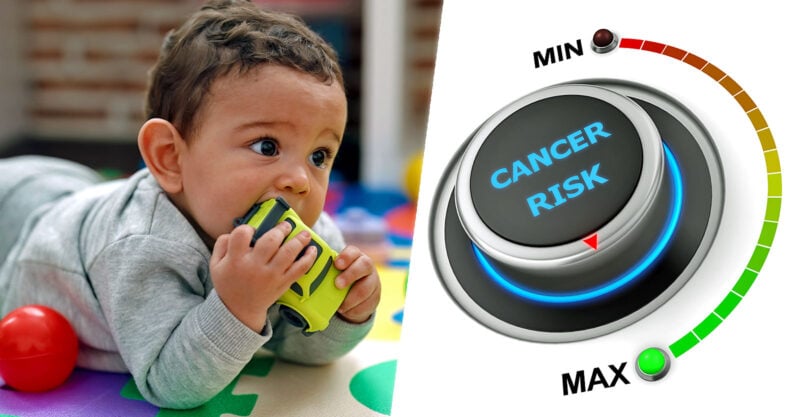Miss a day, miss a lot. Subscribe to The Defender's Top News of the Day. It's free.
By Shannon Kelleher
Everyday plastics may affect many major organs in babies and young children, posing a wide variety of serious health risks as they develop, according to a new report that reviewed 120 recent studies.
Evidence shows potential links between babies’ exposure to plastics and their risk for developing cancer, attention-deficit/hyperactivity disorder (ADHD) and other conditions that may arise when the endocrine system is disrupted, according to the report, which was published in November by the environmental group EARTHDAY.ORG.
Microplastics — bits of plastics smaller than 5 millimeters (microplastics) — have also been found in the human placenta, disrupting communication between a fetus and the mother’s body.
“This isn’t just a simple issue,” said Tom Cosgrove, Chief Creative and Content Officer at EARTHDAY.ORG. “It’s big, the impacts are really broad, and it’s going to take a serious global commitment to get us through this and figure out how we can get to the other side.”
The report was published ahead of a meeting of delegates from 150 countries in Nairobi, Kenya, which discussed details of a Global Plastics Treaty to curb plastic waste.
The deliberations, which concluded on Nov. 19, reportedly made little progress toward finalizing the treaty. While the oil and gas industry advocated for recycling and waste management to control plastic pollution, critics say the treaty must curtail the amount of plastic produced in the first place.
“We’re advocating for a 60% reduction in plastic production by 2040,” said Cosgrove. “There’s just too much there and it doesn’t go away. Every piece of plastic that’s ever been created is still here on the Earth in one form or another.”
Half of the 300 million tons of plastics the world produces each year are single-use. Since alternatives already abound for items such as disposable plastic bags, bottles and straws, cracking down on single-use plastics could make “a huge dent in the whole problem” added Cosgrove.
‘There’s something really troubling here’
While there is already a lot of awareness about plastic pollution, many people don’t realize just how many aspects of human health plastic exposure can impact, said Cosgrove.
To paint a “10,000-foot view” picture of the problem, the researchers combed through recent research, identifying studies on how plastic impacts a wide range of body systems.
“We literally drew a picture of the body and said, ‘let’s start discovering all the different areas where there’s an impact — let’s research the blood-brain barrier, the womb, lungs, heart,’” he said. “Unfortunately, we found something pretty much everywhere.”
The researchers identified studies — some in humans and some in animals — suggesting microplastics accumulate in the urinary system, digestive system, blood, heart, lungs, brain and other major organs.
Babies are particularly vulnerable to ingesting microplastics since they explore the world by putting objects in their mouths.
One study found that babies had 10 times higher levels of some microplastics in their feces than adults, the report revealed. Infants can ingest up to 4.5 million plastic particles per day when fed from polypropylene bottles, which account for the majority of baby bottles used worldwide, according to a 2020 study.
Babies may also ingest microplastics through breast milk, with a 2022 study finding them in 75% of breast milk samples taken from 34 healthy mothers. Toys, clothes, cribs and playgrounds were also identified as major sources of microplastic exposure.
Young children’s overwhelming exposure to common everyday plastics can have debilitating consequences.
Exposure to phthalates, a chemical used to make many plastics, was associated with a 20% higher rate of childhood cancer overall in a study of more than 2,000 childhood cancer cases. Contact with the chemicals was linked to a nearly three-fold higher rate of bone cancer and a two-fold higher rate of lymphoma, a cancer of the blood.
Other research has found higher levels of phthalate and bisphenol A (BPA), another chemical often used in plastics, in children with ADHD compared to children without the condition. Research also points to a potential link between exposure to plastics and traits resembling autism spectrum disorder in mice.
“Some of the research is really extensive and some are preliminary studies, but I think when you put it all together you can’t walk away from it without saying ‘there’s something really troubling here,’” said Cosgrove.
Most of the studies EARTHDAY.ORG reviewed were conducted in the U.S. and Europe, Cosgrove noted, adding that more research is needed to investigate how plastics are affecting babies in the Global South.
“We really need a lot more research done in the rest of the world, where I suspect the impacts are as bad or worse,” he said.
Originally published by The New Lede.
Shannon Kelleher is a staff reporter for The New Lede.






